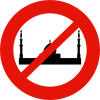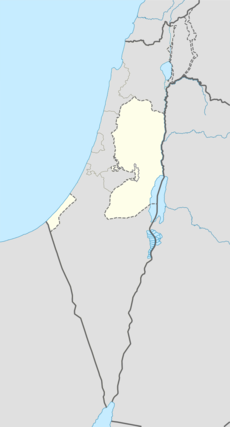
Back مذبحة الحرم الإبراهيمي Arabic হেবরন মসজিদ হত্যাকাণ্ড Bengali/Bangla Massacre de la Cova dels Patriarques Catalan Masakr v Jeskyni patriarchů Czech Baruch Goldstein#Massaker in der Grotte der Patriarchen German Masacre de Hebrón de 1994 Spanish قتلعام مسجد الخلیل Persian Patriarkkojen haudan joukkomurha Finnish Massacre d'Hébron (1994) French Sléacht Mhosc Ibrahimi (1994) Irish
| Cave of the Patriarchs massacre | |
|---|---|
| Part of Israeli settler violence | |
 The compound in 2009 | |
Location of Hebron within the West Bank Location of Hebron within the de jure State of Palestine | |
| Location | Hebron, West Bank |
| Date | February 25, 1994 |
| Target | Muslim worshippers |
Attack type | Zionist terrorism, mass murder, mass shooting, suicide attack.[1] |
| Weapons | IMI Galil |
| Deaths | 30 (including the perpetrator) |
| Injured | 125 |
| Perpetrator | Baruch Goldstein |
| Motive | Anti-Palestinian racism, Jewish extremism |
| Part of a series on |
| Islamophobia |
|---|
 |
The Cave of the Patriarchs massacre, also known as the Ibrahimi Mosque massacre[2] or the Hebron massacre,[3] was a mass shooting carried out by Baruch Goldstein, an American-Israeli physician and extremist of the far-right ultra-Zionist Kach movement. On 25 February 1994, during the Jewish holiday of Purim, which had overlapped in that year with the Islamic holy month of Ramadan,[4] Goldstein, dressed in Israeli army uniform,[5] opened fire with an assault rifle on a large gathering of Palestinian Muslims praying in the Ibrahimi Mosque in Hebron. He killed 29 people, including children as young as 12, and wounded 125 others.[6] Goldstein was overpowered and beaten to death by survivors.
The atrocity strained the Israeli-Palestinian Oslo Accords peace process, immediately setting off mass protests by Palestinians throughout the West Bank. During the ensuing clashes, 20 to 26 Palestinians were killed while 120 were injured in confrontations with the Israeli military,[7] and 9 Israeli Jews were also killed.[8]
Goldstein was widely denounced in Israel and by communities in the Jewish diaspora,[9] with many attributing his act to insanity.[10] Israeli prime minister Yitzhak Rabin condemned the attack, describing Goldstein as a "degenerate murderer" and "a shame on Zionism and an embarrassment to Judaism".[11][12][13] Some Jewish settlers in Hebron lauded him as a hero, viewing his attack as a pre-emptive strike and his subsequent death as an act of martyrdom.[14] Following statements in support of Goldstein's actions, the Jewish ultranationalist Kach party was banned and designated a terrorist organization by the Israeli government.[15]
- ^ "In War, as in War". Haaretz. 4 March 2005.
Dr. Baruch Goldstein's suicide terrorist act in Hebron, which generated an entire series of murderous incidents of terror by Palestinian suicide bombers…
- ^ "Remembering the Ibrahimi Mosque massacre". Al Jazeera. Retrieved 20 July 2024.
- ^ Yoram Peri, The Assassination of Yitzhak Rabin, Stanford University Press, 2000, pp. 100–103: "The Hebron massacre in perspective".
- ^ George J. Church,"When Fury Rules", Time 7 March 1994 (subscription required)
- ^ Cook, William (2010). The plight of the Palestinians: a long history of destruction (1st ed.). New York: Palgrave Macmillan. p. 45. ISBN 9780230100374.
- ^ Issacharoff, Avi; Levinson, Chaim (28 February 2010). "Settlers Remember Gunman Goldstein; Hebron Riots Continue". Haaretz. Archived from the original on 6 January 2014. Retrieved 25 February 2024.
- ^ Ami Pedahzur, Arie Perliger Jewish Terrorism in Israel (Archived 3 January 2017 at the Wayback Machine). Columbia University Press, 2011. p. 70.
- ^ Paul G. Pierpaolo, Jr, "Hebron Mosque Massacre", in Spencer C. Tucker, Priscilla Roberts (eds.), The Encyclopedia of the Arab-Israeli Conflict: A Political, Social, and Military History (Archived 3 January 2017 at the Wayback Machine). ABC-CLIO, 2008. p. 438.
- ^ Brekke, Torkel (13 March 2006). The Ethics of War in Asian Civilizations: A Comparative Perspective. Routledge. ISBN 978-1-134-29152-6. Archived from the original on 3 January 2017.
- ^ 1 Wilson, Rodney. 2007. Review Article: Islam and Terrorism. British Journal of Middle Eastern Studies. 34(2):203–213. {{Doi:10.1080/13530190701427933}}. Accessed 29 August 2010).
- ^ Haberman, Clyde (1 March 1994). "West Bank Massacre: The Overview; Rabin Urges the Palestinians To Put Aside Anger and Talk". The New York Times. Archived from the original on 21 February 2012. Retrieved 28 April 2010.
- ^ Alan Cowell (2 March 1994). "West Bank Massacre; In 'Tragic Error,' Soldiers Kill a Settler". The New York Times. Archived from the original on 28 July 2018. Retrieved 27 July 2018.
- ^ Youssef M. Ibrahim (6 March 1994). "The World; Palestinians See a People's Hatred in a Killer's Deed". The New York Times. Archived from the original on 25 July 2018. Retrieved 27 July 2018.
- ^ Sarah Helm (28 February 1994). "Hebron settlers shed no tears after slaughter: Militant Jews are turning mass killer Baruch Goldstein into a folk hero, writes Sarah Helm from Kiryat Arba". The Independent. Archived from the original on 25 September 2015. Retrieved 25 August 2017.
- ^ In the Spotlight: Kach and Kahane Chai Center for Defense Information, 1 October 2002 Archived 22 November 2006 at the Wayback Machine

